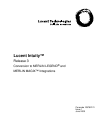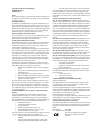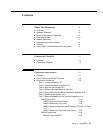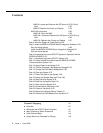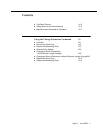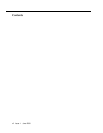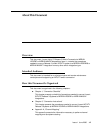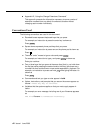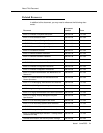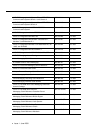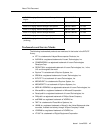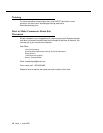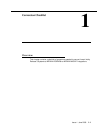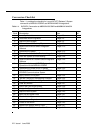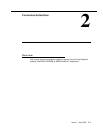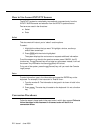
Copyright 2000, Lucent Technologies
All Rights Reserved
Printed in U.S.A.
Notice
Every effort was made to ensure that the information in this book was
complete and accurate at the time of printing. However, information
is subject to change.
Preventing Toll Fraud
“Toll fraud” is the unauthorized use of your telecommunications sys-
tem by an unauthorized party (for example, a person who is not a cor-
porate employee, agent, subcontractor, or working on your company’s
behalf). Be aware that there may be a risk of toll fraud associated with
your system and that, if toll fraud occurs, it can result in substantial
additional charges for your telecommunications services.
Lucent Technologies Fraud Intervention:
If you suspect that you are being victimized by toll fraud and you need
technical assistance or support, call the Technical Service Center’s
Toll Fraud Intervention Hotline at 1-800-643-2353.
Providing Telecommunications Security
Telecommunications security (of voice, data, and/or video communi-
cations) is the prevention of any type of intrusion to (that is, either
unauthorized or malicious access to or use of your company’s tele-
communications equipment) by some party.
Your company’s “telecommunications equipment” includes both this
Lucent product and any other voice/data/video equipment that could
be accessed via this Lucent product (that is, “networked equipment”).
An “outside party” is anyone who is not a corporate employee, agent,
subcontractor, or working on your company’s behalf. Whereas, a
“malicious party” is anyone (including someone who may be other-
wise authorized) who accesses your telecommunications equipment
with either malicious or mischievous intent.
Such intrusions may be either to/through synchronous (time-multi-
plexed and/or circuit-based) or asynchronous (character-, message-, or
packet-based) equipment or interfaces for reasons of:
• Utilization (of capabilities special to the accessed equip-
ment)
• Theft (such as, of intellectual property, financial assets, or
toll-facility access)
• Eavesdropping (privacy invasions to humans)
• Mischief (troubling, but apparently innocuous, tampering)
• Harm (such as harmful tampering, data loss or alteration,
regardless of motive or intent)
Be aware that there may be a risk of unauthorized intrusions associ-
ated with your system and/or its networked equipment. Also realize
that, if such an intrusion should occur, it could result in a variety of
losses to your company (including but not limited to, human/data pri-
vacy, intellectual property, material assets, financial resources, labor
costs, and/or legal costs).
Your Responsibility for Your Company’s Telecommunications
Security
The final responsibility for securing both this system and its net-
worked equipment rests with you – a Lucent customer’s system
administrator, your telecommunications peers, and your managers.
Base the fulfillment of your responsibility on acquired knowledge and
resources from a variety of sources including but not limited to:
• Installation documents
• System administration documents
• Security documents
• Hardware-/software-based security tools
• Shared information between you and your peers
• Telecommunications security experts
To prevent intrusions to your telecommunications equipment, you and
your peers should carefully program and configure your:
• Lucent-provided telecommunications systems and their
interfaces
• Lucent-provided software applications, as well as their
underlying hardware/software platforms and interfaces
• Any other equipment networked to your Lucent products.
Lucent Technologies does not warrant that this product or any of its
networked equipment is either immune from or will prevent either
unauthorized or malicious intrusions. Lucent Technologies will not be
responsible for any charges, losses, or damages that result from such
intrusions.
Federal Communications Commission Statement
Part 15: Class A Statement. This equipment has been tested and
found to comply with the limits for a Class A digital device, pursuant
to Part 15 of the FCC Rules. These limits are designed to provide rea-
sonable protection against harmful interference when the equipment is
operated in a commercial environment. This equipment generates,
uses, and can radiate radio-frequency energy and, if not installed and
used in accordance with the instruction manual, may cause harmful
interference to radio communications. Operation of this equipment in
a residential area is likely to cause harmful interference, in which case
the user will be required to corect the interference at his/her own
expense.
Part 15: Personal Computer Statement. This equipment has been
certified to comply with the limits for a Class B computing device,
pursuant to Subpart J of Part 15 of FCC Rules. Only peripherals
(computing input/output devices, terminals, printers, etc.) certified to
comply with the Class B limits may be attached to this computer.
Operation with noncertified peripherals is likely to result in interfer-
ence to radio and television reception.
Part 68: Network Registration Number. This equipment is regis-
tered with the FCC in accordance with Part 68 of the FCC Rules. It is
identified by FCC registration number AS5USA-20411-VM-E.
Part 68: Answer-Supervision Signaling. Allowing this equipment to
be operated in a manner that does not provide proper answer-supervi-
sion signaling is in violation of Part 68 rules. This equipment returns
answer-supervision signals to the public switched network when:
• Answered by the called station
• Answered by the attendant
• Routed to a recorded announcement that can be adminis-
tered by the CPE user
This equipment returns answer-supervision signals on all DID calls
forwarded back to the public switched telephone network. Permissi-
ble exceptions are:
• A call is unanswered
• A busy tone is received
• A reorder tone is received
Canadian Department of Communications (DOC)
Interference Information
This digital apparatus does not exceed the Class A limits for radio
noise emissions set out in the radio interference regulations of the
Canadian Department of Communications.
Le Présent Appareil Nomérique n’émet pas de bruits radioélectriques
dépassant les limites applicables aux appareils numériques de la class
A préscrites dans le reglement sur le brouillage radioélectrique édicté
par le ministére des Communications du Canada.
Lucent Technologies Fraud Intervention
If you suspect that you are being victimized by toll fraud and you need
technical support or assistance, call BCS Technical Service Center
Toll Fraud Intervention Hotline at 1 800 643-2353.
European Union Declaration of Conformity
Lucent Technologies Business Communications Systems declares that
the equipment specified in this document conforms to the referenced
European Union (EU) Directives and Harmonized Standards listed
below:
EMC Directive 89/336/EEC
Low-Voltage Directive73/23/EEC
The “CE” mark affixed to the equipment
means that it conforms to the above
directives.



